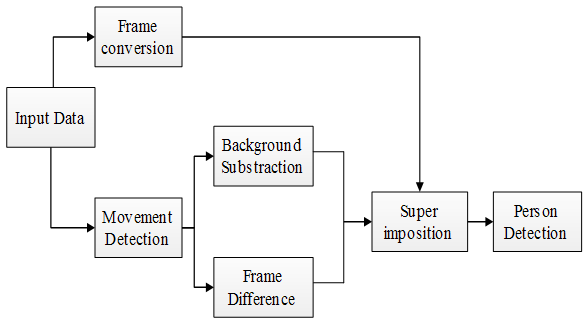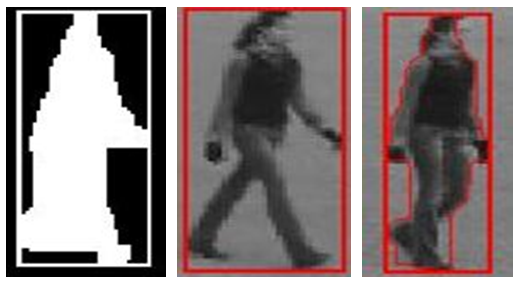-
Paper Information
- Next Paper
- Paper Submission
-
Journal Information
- About This Journal
- Editorial Board
- Current Issue
- Archive
- Author Guidelines
- Contact Us
American Journal of Intelligent Systems
p-ISSN: 2165-8978 e-ISSN: 2165-8994
2017; 7(3): 47-49
doi:10.5923/j.ajis.20170703.01

Extraction of Person Body using Appearance & Feature based Algorithms
Samhitha Upadhyaya, Sujatha M.
Department of Computer Science and Engineering, St Joseph Engineering College, Mangaluru, India
Correspondence to: Samhitha Upadhyaya, Department of Computer Science and Engineering, St Joseph Engineering College, Mangaluru, India.
| Email: |  |
Copyright © 2017 Scientific & Academic Publishing. All Rights Reserved.
This work is licensed under the Creative Commons Attribution International License (CC BY).
http://creativecommons.org/licenses/by/4.0/

Extraction is considered to be challenging with person body because of various conditions involved inclusive of pose space with high dimension, complex scene features, size involved with image, pose variance and variant person appearance, almost all existing work involves the vigorous training and matching of templates, the proposed method includes the algorithm which is combination of feature and appearance data involved in the complete process. The dimension and person’s color with size is considered as fact for identification along with separation among the feature and appearance. Some of the anthropometric set of constraints is being used for the skin color estimation and the combined approach is applied at different level in order to correctly estimate the person body. The feature data estimation includes detection of edge from the image and appearance data extraction including the color of image and shape of image under different illuminant condition. The segments from different regions are combined estimation of foreground and the background during search process.
Keywords: Backdrop Eviction, Frame Conversion, Superimposition
Cite this paper: Samhitha Upadhyaya, Sujatha M., Extraction of Person Body using Appearance & Feature based Algorithms, American Journal of Intelligent Systems, Vol. 7 No. 3, 2017, pp. 47-49. doi: 10.5923/j.ajis.20170703.01.
Article Outline
1. Introduction
- Knowledge about the different regions is the major concern in detection aiding to person layout determination that corresponds to recognizing from the static image data and the recognition of signs involving data estimation. The segmentation of person body is the common scenario where all video data can be estimated with the background data is available and the motion of person is idealized by the subtracting background. The frame level subtraction is also one fact considered by differentiating among different frames to felicitate the recognition by action.In this study the proposed method is concerned with the segmentation using background subtraction.The problem is divided into sequential step which includes the motion detection, foreground estimation and then the person’s body identification. The movement of the person is estimated by converting the video data into different frames and then finding the difference between them, the absolute dependency factor is number of person in the frame and the size of the video data used for the estimation. The edge detection is applied for the image data and video data making use of appropriate detector. Finally the person detection algorithm is applied to the detected edge so that person is determined accurately.The contribution of proposed methodology address for the upright estimation of pose, size and shape which includes• Segmentation done automatically for the person’s body present in image data and the video data • The combination of different approach applied at different levels with feature and appearance by correlating the pixel combination.• The detection of edge using appropriate detector and the frame difference mechanism for movement detection• With making the following assumption finally the person body detected applied to torso.
2. Related Work
- The approaches classified include the interactive approach that expect the user to differentiate the level into separate foregrounds and backgrounds, the accuracy depends on the input image or the input video data. The methodology is applied to low level to employ the specificity of image with compulsory automation. The object specificity is the major concern involving the size and shape constraints for the accurate person detection [1].The theory proposes objective functions which consist of two components called balancing term and entropy rate of random walk. Construction of graph takes place that will induce a mastoid further a greedy algorithmic technique is implemented to by exploiting the submodular properties of objective function. Validation of results done on certain benchmarks, in contrary a hypergraph clustering with edges and vertices is being proposed [2].In order to faces a robust face detection algorithm is being proposed which features color constancy using the manual Local-Global matching technique. The module includes potential face region extraction module which is based on region of interest and face detection module. The algorithm is designed by calculating centroid point to extract potential eye and mouth regions with a nose points [3].A study is carried based on the disadvantages of using the traditional classifiers which includes time consumed to manually annotate the training dataset or the data in the dataset is over- generalized. Global detection technique is applicable in learning changing skin model using thermal infrared rays and changes in lamination to learn the exact Appearance of skin, in addition to global detection method Kendall’s τ function usage is proposed [4].A survey based on clustering algorithm which implies Computer vision technique where it is necessary for the machine to see people activities. The skin detection algorithm which has to deal with illumination sensitivity. An art installation called 15 Seconds of Fame where skin is Identified as cluster. The models which are generated are two dimensional and gives better compactness of skin regions. In addition to previously developed model they propose 3D models where performance is enhanced with various model used [5].The paper describes about recognition and identification of human body based on pixel. The survey analysis is based on identification of human figure and localizing his limbs along with a pixel. Survey is carried on baseball player dataset with different clothing and poses. Finally the result on torso detection is shortlisted. A problem is identification of human figure precisely [6].
3. Methodology
3.1. Frame Conversion
- The video data is the sequence of image frames, so the conversion of video into single image frames is the task achieved in order to perfectly identify person’s body. The aspect to be considered is the mean differential value for the video data. This method is most appropriate for varying environment condition, the value of threshold is set on the basis of environment changes. The single component RGB is extracted by taking the background median between the frames. The background image is set to be non variable, each time the difference is taken.
3.2. Movement Detection
- The moving object detection is based on the segmentation in a video data. The conventional approach followed during these years include the optical flowing criteria, background elimination criteria, temporal filtering of spatial data which are described in following section below.
3.3. Backdrop Eviction with Foreground Extracted
- • The most popular method used in person detection with segmentation being formed by block fashion with the two frame distinction, such as current frame and referential frame in the pixel by pixel manner. The scene change is to be considered adaptively, with corresponding time intervals. • The moving object classification is well established way for video data and real time data extracted from camera which helps the new ideas to grow in the field of detection.• The model to be in practice is Gaussian model which is for dynamic environment change and change in size and shape.
3.4. Person Detection
- The person detection is last step after the detection of object in movement, where the process in overall has three steps conducted sequentially for different set of frames from video data. The new video data is represented as the integral frame set which requests all feature to be detected correctly with application of some vision techniques. The algorithm learning on the adaboost technology which select the smallest possible features from the largest data efficiently. The third step is the combination of all smallest feature into cascade which allows background image data removal in the quickest way as possible.
 | Figure 1. Overview of Person Detection & Recognition |
4. Result
- The performance estimation is mainly on the mean and the standard deviation value taken for different datasets with variable size video data. The Tables below shows the comparison of score value considering mean and standard deviation, and hence the accuracy is measured. The size of video considered for both the methods remain unchanged. The value of standard deviation is small indicating the increase in accuracy of proposed system.
|
|
 | Figure 2. Result of Person detection & Identification |
5. Conclusions
- The advantage of the proposed method is on the tested methods include the localization of segments automatically under change in size and shape of the video data. The stability is shown with the smallest standard deviation in the complex environment tested for different dataset of variable file size. The combination of segments at different levels yields the result from course to fine. During overall searching process the regions are well differentiated with foreground detection, filters are applied to accurately detect the humans in different conditions. Experiment is set to be challenging with large datasets and with increasing level of complexity scene. However the assumption taken at some point help in detection for better result. There is scope for improvement in the detection of foreground with efficient algorithm.
 Abstract
Abstract Reference
Reference Full-Text PDF
Full-Text PDF Full-text HTML
Full-text HTML
